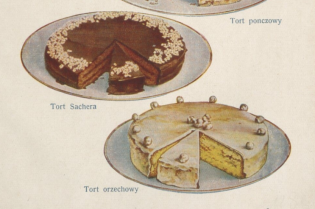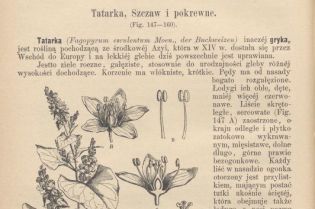Herbaria: chickpeas, skirret and poorer quality meat
Information about what the inhabitants of Krakow ate during the Renaissance can be derived from herbaria.
Herbaria contributed to the propagation of soup vegetables. Italian eating habits were popularized in the work "On mysterious and secret medicines" written by Alex Pedemontan and translated by Marcin Siennik. The recipes published in the herbaria were reprinted in calendars that appeared in the following centuries.
Many of the herbaria published in the 16th century are translations of works published in other European countries. Some, however - like Szymon Syreniusz’s work, "Herbarium, (Herbasz from Latin..)." or "Herbarz" by Marcin from Urzedów are based not only on translations, but also conversations with herbalists, and their intention was to popularize native medicinal plants.
When reading herbaria, remember that their authors treated food as medicine. Between the lines we are able to learn a lot about what the diet of the inhabitants of Poland during the Renaissance period was like.
Marcin Kromer described the differences in the diet of the sixteenth-century residents of Krakow and the surrounding area: "Food from the old times, namely in the rural population, consisted of pork, milk, fish and vegetables. Today, when many people use wethers, calves and oxen meat, slaughtering in the villages near the parish churches takes place on public holidays. Foods of the nobility and burghers are more sophisticated and nutritious, their tables are generously filled with game, birds and various fish, for which fragrances, sugar and all kinds of foreign spices are used. There is no shortage of more sophisticated vegetables, and many homemade delicacies, even those from brought from abroad. Using wheat bread and wine, which was formerly a noble custom, today has become so popular and widespread that they even use both for their feasts. Regardless of price, they bring wine to the Malopolska Region, from Hungary and Moravia".
The tips from Stefan Falimirz, author of "On herbs and their power" are interesting and suggest to season zander, catfish or cod – the so-called "poor quality fish", "with little taste" by using local and cheap spices - garlic, horseradish and mustard seed. For better fish (salmon, lamprey, sturgeon, vimba) adding roots was recommended, and native spices were only used as a last resort. From Syreniusz, on the other hand, we can learn that the dishes assigned to the poorer social group were beetroots the so-called "vegetables of the poor", bread soup and barley. Social status was also evidenced by the degree of milling of the grain: "groat pulps for domestic servants and the finer ones, beautiful as pearls, for the nobility and royal tables."
Herbaria are also an invaluable source of knowledge about what vegetables and fruits were grown in today's Malopolska Region. In "Herbarz" Marcin from Urzędów, even mentions that in Kraków's Zwierzyniec, at the request of Queen Bona, chickpeas were planted.
Herbaria are also a clue when looking for flavors that have already been forgotten by Polish cuisine. As an example, the roots of a plant from the Umbelliferous family: skirret called "sugar root” (or kucmorka and in the accounts of the royal court it is called cruczmorka or cuczmorka). Süreniusz in "Herbarium" writes about it: "Kucmorka is close kin to those we used to eat ... For those of us in Poland, and especially in Krakow, it is seeded during the days following blackthorn winter. It is not known elsewhere and they use it for strength during Lent. It is pleasant to the stomach and a useful dish especially when boiled. It is commonly boiled with rice and with raisins. Also, instead of fish, it is fried in butter or in olive oil, after being cooked then dipped in wheat flour or in a bagel dough and fried in butter or hot olive oil, and seasoned with some salt and pepper. Others do not boil it first, but fry it raw, until they are well-browned, then put it on the meat and cook it until soft, then add some wheat flour to make the soup thick and eat it with white bread and ground sugar. A little bit of ground pepper will make this dish very unique. For those with consumption, this dish is very useful: after cooling the roots, cut into slices, boil in fresh milk until soft, then strain it. You can have skirret as a salad - clean the roots, take care of them well, place in cold water, add salt and vinegar, and season with oil." It is not always easy to identify which type of plants the authors of herbaria were referring to. This is the case with skirret. This name was used both for the marsh woundwort (Stachys palustris) and the main name skirret (Sium sisarum). Sreniusz wrote about the second one of these.










